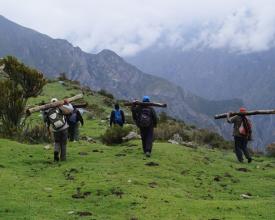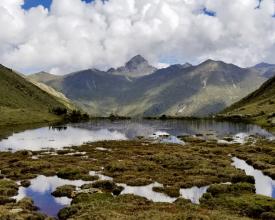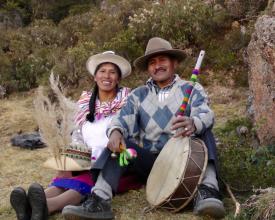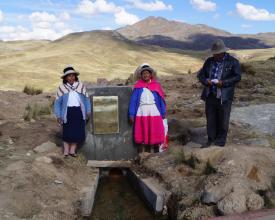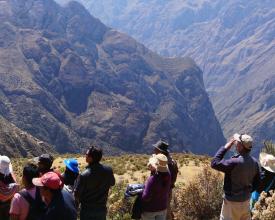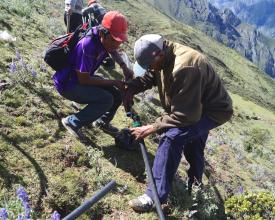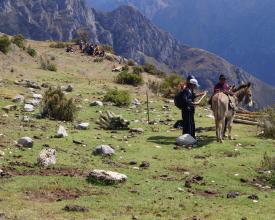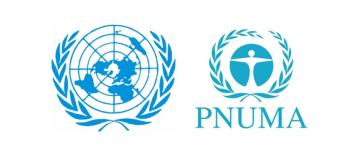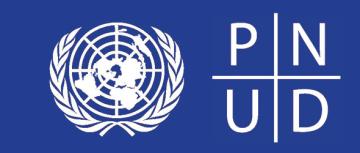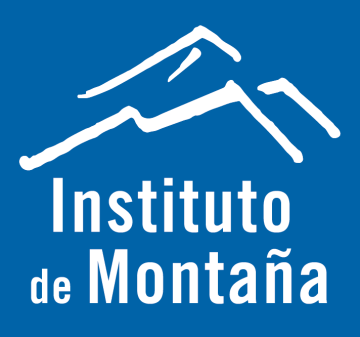
Restauration d'anciens systèmes de gestion de l'eau dans les hautes Andes en tant qu'adaptation au changement climatique - Miraflores, Pérou
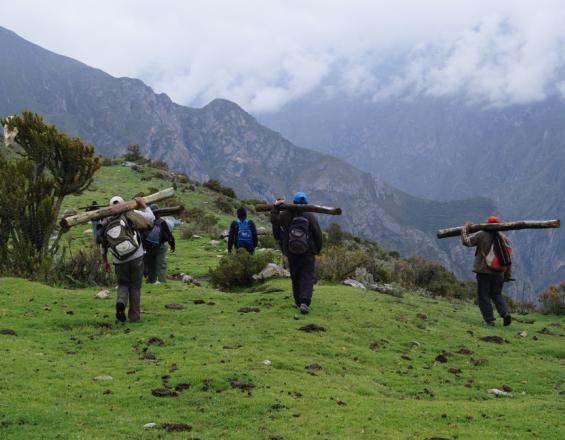
Une mesure d'adaptation basée sur l'écosystème (EbA) a été mise en œuvre par la communauté de Miraflores et l'Institut de la montagne, en partenariat avec la réserve paysagère Nor Yauyos Cochas et l'UICN. Notre solution d'adaptation combine les connaissances traditionnelles (indigènes) et locales avec les dernières avancées scientifiques et comprend trois composantes : (1) le renforcement des organisations et des institutions communautaires, (2) le renforcement des capacités et des connaissances locales et (3) la combinaison des infrastructures vertes et grises. En collaboration avec des écologistes, des ingénieurs et des anthropologues, les membres de la communauté de Miraflores ont décidé de remettre en état un ancien système de gestion de l'eau conçu par leurs ancêtres et datant de 700 ans. Ce système rénové est un hybride d'infrastructure grise (construite) et verte (issue de la nature) qui tire le meilleur parti de l'ingénierie ancienne et de la science moderne. Nous avons pu rétablir l'écoulement de l'eau dans les prairies et pâturages indigènes et améliorer la gestion du bétail et des pâturages, ce qui constitue une adaptation essentielle au changement climatique.
Contexte
Défis à relever
Principaux défis de la communauté de Miraflores :
- Faible organisation communale
- Faible productivité du bétail en raison de la dégradation des pâturages et du manque d'eau
- Pénurie générale d'eau
- Pénurie de main-d'œuvre due à la migration
- Dégradation des pâturages de montagne et des zones humides (lagunes artificielles pré-incas) en raison du surpâturage
- Croissance minimale des pâturages en raison d'une rotation insuffisante des pâturages pour donner aux prairies le temps de se reconstituer
Emplacement
Traiter
Résumé du processus
Les éléments constitutifs contribuent à la durabilité de l'initiative. L'infrastructure technologique combinée à des mesures visant à renforcer les capacités techniques et organisationnelles constitue la base d'une mise en œuvre et d'une maintenance durables de la mesure.
Blocs de construction
Renforcement de l'organisation et des institutions communautaires
Un plan de gestion des pâturages et de l'eau a été élaboré pour promouvoir la gestion intégrée des pâturages, de l'eau et des ressources en bétail sur l'ensemble du territoire communal de Miraflores. L'objectif était de renforcer l'organisation communautaire afin que l'eau puisse être distribuée plus efficacement et que les zones de pâturage puissent bénéficier d'une meilleure rotation. Le processus d'élaboration du plan de gestion a été facilité par l'Institut de la montagne, qui a utilisé une méthodologie visant à renforcer les capacités et à stimuler les pratiques collectives et sociales au sein de la communauté. Le plan est défini comme un ensemble d'idées qui émergent d'une population donnée, sur la base de ses propres perspectives. Il est réalisé au moyen d'un processus d'analyse approfondi. Le plan de gestion peut également servir d'outil de gestion locale à moyen terme.
Selon le vif intérêt de cette communauté, l'analyse et la planification se sont concentrées sur les prairies et l'eau. Le plan a également encouragé la communauté à créer un comité chargé de l'entretien et de l'exploitation des infrastructures hydrauliques rénovées, afin que l'eau continue de couler et que les prairies continuent d'être irriguées.
Facteurs favorables
- Intérêt et engagement de la population locale
- Participation de l'équipe de la réserve paysagère de Nor Yauyos Cochas (NYCLR)
- Engagement et soutien des autorités communales et municipales
- Alignement des intérêts entre le projet et la réserve paysagère de Nor Yauyos Cochas, l'autorité nationale des aires protégées (SERNANP), la communauté de Miraflores et la municipalité.
- Participation d'experts locaux et externes et interactions utiles et positives entre eux et les membres de la communauté
- Approche participative, méthodologie de recherche-action participative et communication efficace.
Leçon apprise
- Compte tenu du manque de confiance initial de la communauté dans les institutions extérieures, la présence constante du personnel de terrain de l'Institut de la montagne et son implication dans la vie quotidienne de la communauté ont été très importantes. Les activités de communication ont contribué à renforcer la confiance et la participation, ainsi que l'appropriation locale.
- Il est essentiel que l'équipe de terrain soit formée à l'application de l'approche participative, à l'utilisation des outils participatifs et à la facilitation de l'apprentissage collectif.
- Pour développer la capacité de la communauté à gérer les plans de gestion, il est important de renforcer ses liens avec les autorités locales et/ou régionales qui peuvent encourager l'initiative de la communauté et qui seront probablement impliquées dans la mise en œuvre du plan.
- Il est important de consacrer encore plus de temps à la conception et à la mise en œuvre participatives du plan de gestion des pâturages et de l'eau.
- Il est utile de promouvoir la consolidation des accords de gouvernance.
Ressources
Renforcer les capacités et les connaissances locales
L'objectif principal de la composante "renforcement des capacités et des connaissances locales" était de fournir des connaissances techniques pour la gestion et la conservation de l'eau, des pâturages naturels et du bétail. Nous nous sommes concentrés sur l'information des membres de la communauté et des gardes du parc par le biais d'ateliers d'évaluation et de sessions de formation sur des sujets tels que la clôture des pâturages, la gestion de l'eau et la distribution de l'eau. Un modèle 3D de la communauté de Miraflores a été développé de manière participative afin de faciliter la planification de la gestion des pâturages et de l'eau sur le territoire communal. Des informations ont été recueillies au cours d'évaluations rurales participatives. Ces évaluations comprennent des études spécifiques axées sur l'eau, les pâturages, l'archéologie, l'organisation sociale, la productivité agricole et animale.
Facteurs favorables
- Utilisation d'outils de communication pour accroître la sensibilisation et la compréhension du projet au niveau local
- Connaissances locales et traditionnelles et dialogue avec les experts extérieurs : la participation locale et les interactions positives entre les habitants et les experts extérieurs ont permis une communication efficace entre eux.
- Approche participative et méthodologie de recherche-action participative
- Les chercheurs locaux ont servi de pont entre le projet et l'ensemble de la communauté.
Leçon apprise
- Il est essentiel que l'équipe de terrain soit formée à l'application de l'approche participative, à l'utilisation d'outils participatifs et à la facilitation de l'apprentissage collectif.
- Diversifier le travail avec les partenaires locaux - combiner les ateliers avec d'autres méthodes, des outils pratiques et le travail sur le terrain ("apprendre par la pratique").
- Développer des activités qui impliquent les femmes, les jeunes et d'autres groupes au sein de la communauté.
- Maintenir un niveau élevé de présence sur le terrain et partager le travail quotidien avec la communauté.
- Fournir une formation plus pratique pendant le travail sur le terrain.
- Les stratégies de communication ont permis de diffuser les réalisations et les progrès en cours du projet. Ces mises à jour ont été bien accueillies et ont eu un bon impact. Les vidéos participatives et le théâtre "Night of Art" en sont des exemples.
Amélioration des infrastructures de gestion des eaux grises et vertes et des prairies
Dans le cadre du volet infrastructure, les actions suivantes ont été menées :
- extension de la zone clôturée de la zone humide de Yanacancha,
- réparation de la canalisation d'eau de Yanacancha : segment de Curiuna à Huaquis.
- sectorisation (par clôture) de Curiuna à Tuntinia,
- la réparation et la construction de cinq points d'eau (Curiuna, Wayacaña, Pampalpa, Colulume et Tuntinia), et
- la construction d'une "grotte d'eau" à l'entrée de Huaquis.
Lors de la mise en œuvre de ce volet, la communauté a apporté sa contribution en effectuant des tâches communes. La communauté était également responsable du transfert des matériaux de construction vers cette région isolée.
Facteurs favorables
- La confiance et les bonnes relations se sont développées entre l'équipe du projet et la communauté.
- Une communication ouverte et respectueuse est un élément central.
- Intérêt local, participation des gestionnaires de la réserve de la CNJL et engagement et soutien des autorités communales.
- Des relations solides et une coordination efficace entre l'Institut de la montagne, les gestionnaires de la réserve de NYCL et l'autorité nationale chargée des zones protégées (SERNANP).
Leçon apprise
- Au cours de la phase de planification, prévoyez suffisamment de temps pour les activités essentielles telles que les travaux d'infrastructure, le suivi de l'impact, la communication et la systématisation des résultats.
- La main-d'œuvre locale/le travail communal pour le développement et/ou l'entretien des infrastructures peut prendre plus de temps que prévu.
- Rechercher l'engagement et le soutien des autorités locales et les impliquer dans les processus décisionnels clés. Établir des partenariats avec les autorités locales afin de rendre la mesure EbA plus durable.
- Présenter le budget de la mesure d'EbA à la communauté et demander aux habitants d'y contribuer. Cette contribution peut prendre la forme de main-d'œuvre, d'expertise, d'équipement, de matériel et/ou de fonds, etc.
- Analyser soigneusement les éventuelles incidences environnementales et sociales des mesures d'EbA et élaborer une stratégie d'atténuation et de gestion des risques.
- Mettre en œuvre les mesures d'EbA selon une approche de gestion adaptative ("Tout n'est pas fait correctement dès le premier jour"). En d'autres termes, prévoir de s'adapter au fur et à mesure de l'avancement du projet.
Impacts
La zone qui protège les zones humides, les lagunes et les digues ancestrales à Yanacancha a été étendue de 3 à 5 ha. La couverture végétale de la zone clôturée a tendance à s'améliorer, passant de 69 % à 90 %. La réparation de la canalisation a permis d'augmenter l'approvisionnement, la disponibilité et la distribution de l'eau dans des zones plus étendues. La communauté de Miraflores a accepté de préserver et de récupérer 160 ha de pâturages naturels pendant huit mois par an, durant la saison sèche. La communauté a élaboré son "plan de gestion des pâturages et de l'eau" de manière participative. Ce plan comprend des activités à long terme et identifie des objectifs de conservation qui sont alignés sur les objectifs du plan directeur de la réserve paysagère de Nor Yauyos-Cochas. Un espace de dialogue entre différents groupes - communautés paysannes/indigènes, gouvernements et agences gouvernementales, universités et recherche, ONG et secteur privé - a été créé pour favoriser les synergies en matière de financement et de soutien technique pour la gestion durable des écosystèmes de prairies (en mettant l'accent sur le plan de gestion des pâturages et de l'eau).
Bénéficiaires
- Directement : 80 familles (environ 400 personnes) dans la communauté de Miraflores.
- Indirectes : Populations vivant dans la partie moyenne et inférieure du bassin versant.
Objectifs de développement durable
Histoire
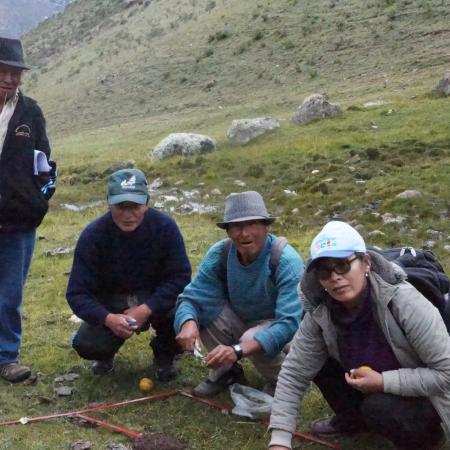
Extrait de Raúl Crispin Robladillo, garde forestier :
Au début, l'adaptation basée sur les écosystèmes était quelque chose de nouveau pour nous. En travaillant dans la région (réserve paysagère de Nor Yauyos-Cochas), nous connaissions la conservation et la préservation des ressources naturelles, mais nous ne savions pas grand-chose de l'adaptation fondée sur les écosystèmes. Mais nous avons fait connaissance.
Lorsque ce projet a démarré, nous avons été quelque peu choqués par le fait que les membres de la communauté pouvaient apporter leur contribution. Et cette contribution, c'était leur main-d'œuvre. Ce n'était pas habituel. Mais cela leur permet d'apprécier le travail communautaire qu'ils ont accompli.
Comme ce projet leur donne la possibilité de faire de petites clôtures, de transférer de l'eau et de gérer les pâturages, ils commencent aussi à voir que leurs activités futures seront liées à cela. Le travail avec les jeunes a été important. C'est comme s'ils avaient retrouvé leur identité, parce que dans tout le travail qu'ils ont fait, ces jeunes ont appris de leurs ancêtres, en comprenant comment ils travaillaient il y a longtemps. Ils sont donc conscients de leur histoire, de leur vie actuelle et de la façon dont ils envisagent l'avenir. C'est important, car les jeunes jouent un rôle important dans leur foyer et aident parfois leurs parents à comprendre.
Je pense que la question de l'organisation s'est améliorée. Les familles construisent déjà des clôtures afin d'améliorer les pâturages. Elles savent très bien qu'elles ne peuvent pas acheter du meilleur bétail si elles n'ont pas assez d'herbe.
Auparavant, les plans élaborés au sein de la communauté étaient irréalistes, non participatifs et n'avaient rien à voir avec les communautés. Le plan de gestion participative des herbages et de l'eau qui vient d'être élaboré est important. Les habitants eux-mêmes ont assumé la responsabilité et veulent qu'il soit mis en œuvre, en commençant par les actions les plus prioritaires. Ils envisagent déjà de s'adresser au maire pour lui demander d'inclure les souhaits des citoyens dans les budgets participatifs. Et il ne s'agit pas d'une seule personne, mais de la majorité de la communauté.
Nous sommes en train de mettre à jour le plan directeur de la réserve paysagère et ce projet EbA s'inscrit dans le cadre de notre plan. Les gardes forestiers ont été formés à l'évaluation des pâturages, etc. À l'avenir, ils continueront à fournir une assistance technique aux membres de la communauté, car cela s'inscrit dans le cadre de ce que nous voulons en tant que réserve. Par conséquent, ils auront déjà acquis les connaissances de base pour pouvoir reproduire le cours. Je pense qu'il sera important de pouvoir assurer la continuité de tout cela dans les communautés.

